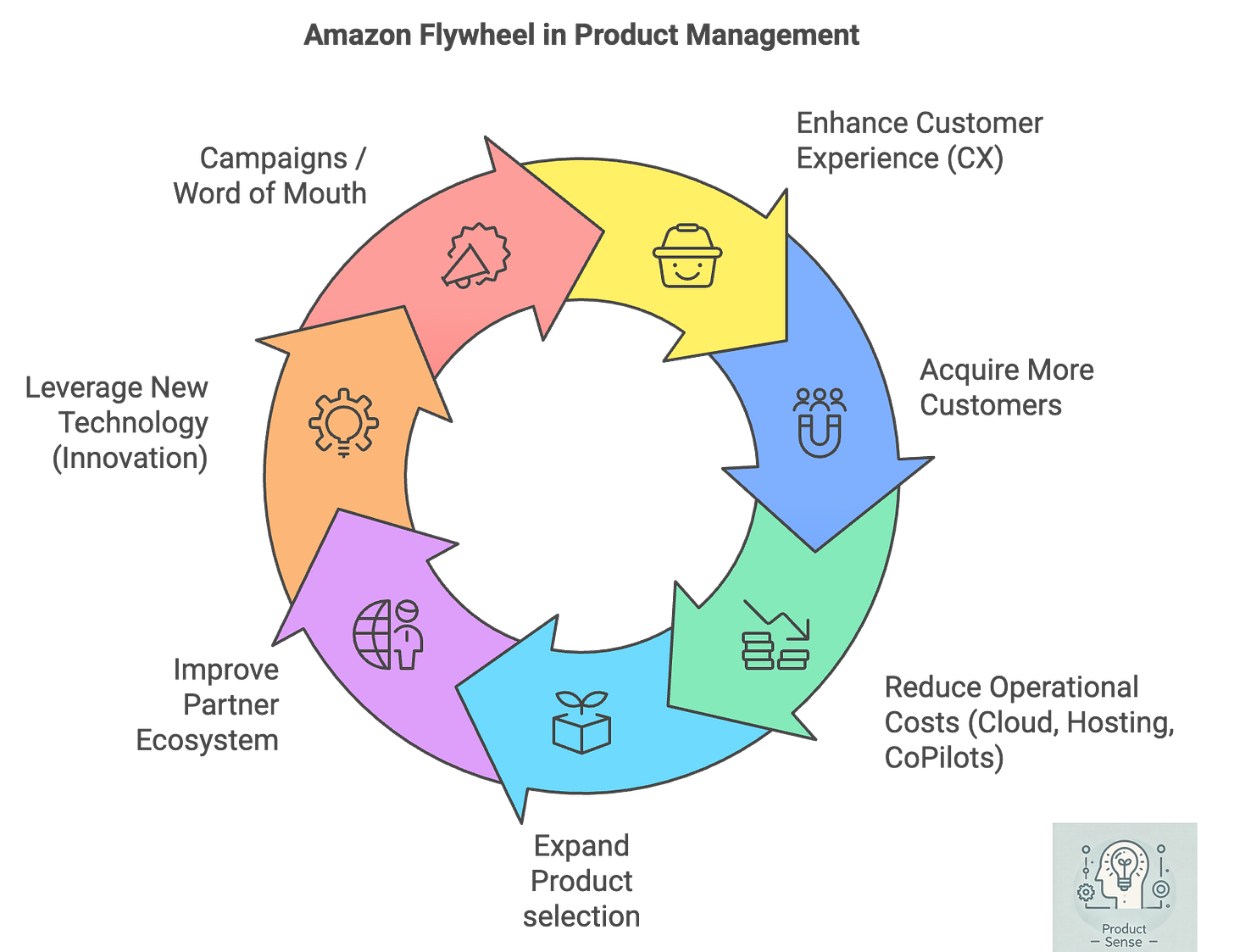How to apply Amazon’s flywheel to Product management
Product Sense Masterclass #6 : Amazon’s flywheel for Product management
The Amazon’s Flywheel is a business model framework introduced by Jim Collins and adopted by Amazon to drive growth and create a self-reinforcing cycle of success.
The flywheel concept centers around the idea that key components of a business, when optimized, feed into each other and generate momentum for continued growth.
In product management, applying the flywheel concept involves focusing on improving different aspects of the product and user experience, which in turn positively impacts other areas and drives growth.
Here’s how the Amazon flywheel can be applied to product management with specific examples:
1. Customer Experience (CX)
At the core of the flywheel is creating a superior customer experience. In product management, the focus should be on continuously enhancing product usability, performance, and satisfaction.
Example: A product team managing an e-commerce app might improve navigation and reduce friction in the checkout process. This leads to better user satisfaction, which results in higher conversion rates and repeat customers.
2. Customer Acquisition
The more customers a product attracts, the more it benefits from network effects, social proof, and referrals. Product managers should develop features that encourage organic growth through increased visibility.
Example: Introducing a referral program or incentivizing reviews can increase traffic. For instance, Dropbox famously implemented a referral system where both the referrer and referred user received extra storage space, driving customer acquisition exponentially.
3. Lower Costs:
Higher traffic and sales volume lead to economies of scale, reducing the overall cost of customer acquisition and product delivery.
Example : In a SaaS (Software as a Service) product, as user adoption grows, operational costs for the product (such as cloud infrastructure) become more efficient, enabling the company to offer lower subscription rates or add more features without increasing prices, thereby attracting more users.
4. Greater Product Selection
Expanding product offerings or feature sets increases value for customers, enhancing user experience and bringing in more customers. This in turn increases traffic, lowering costs further.
Example: A project management software might start by offering basic task management features. Over time, it can add features like time tracking, Gantt charts, or integrations with other tools, making it more attractive to a wider audience, bringing in more users, and fueling further product development.
5. Enhanced Seller/Partner Ecosystem
In cases where product management involves third-party contributions (like app stores or partner integrations), improving the ecosystem can lead to more offerings for users, better customer experience, and increased adoption.
Example : Amazon Web Services (AWS) enables third-party developers to build and sell their services through the AWS Marketplace. This increases AWS's overall offerings, enhances the user experience, and attracts more customers, which further boosts traffic and lowers costs.
6. Leverage latest technology and deliver new delightful features
Investing in innovative technology or features directly contributes to better customer experience and differentiates the product from competitors.
Example : A product like Slack continuously improves with new features like Huddle (voice chat) or better integrations with other work tools (such as Jira or Trello). This increases user satisfaction, encourages team-wide adoption, and ultimately drives traffic and word-of-mouth growth.
7. Word of Mouth / Campaigns/ Success Stories
As customer experience improves and more customers are acquired, positive word-of-mouth and organic promotion accelerate the flywheel’s spin, leading to exponential growth.
Example : A product like Notion gained immense popularity not through traditional marketing but through user-generated content, tutorials, and community-driven projects. Its growing user base promotes the product, creating a self-reinforcing cycle of user acquisition.
Putting it All Together:
In product management, the goal is to align efforts to continuously improve the user experience, expand product offerings, reduce costs through efficiencies, and attract more users, all of which fuels further growth. The product manager acts as a key driver of this flywheel by identifying opportunities in each component (CX, traffic, cost efficiency, and ecosystem) and ensuring they all work together.
By integrating the Amazon Flywheel into product management, companies can create a sustainable and scalable product growth engine.




